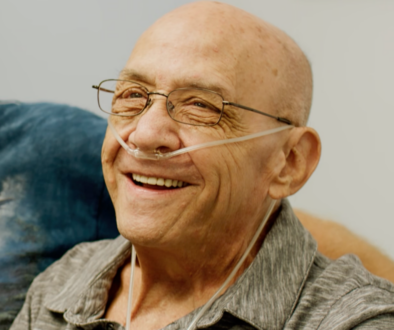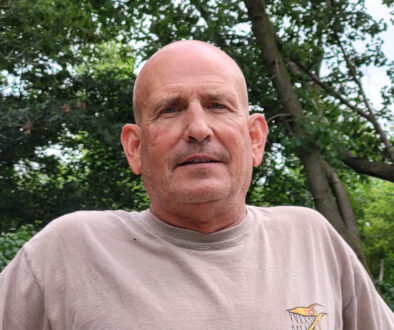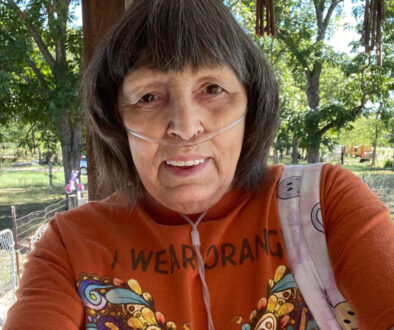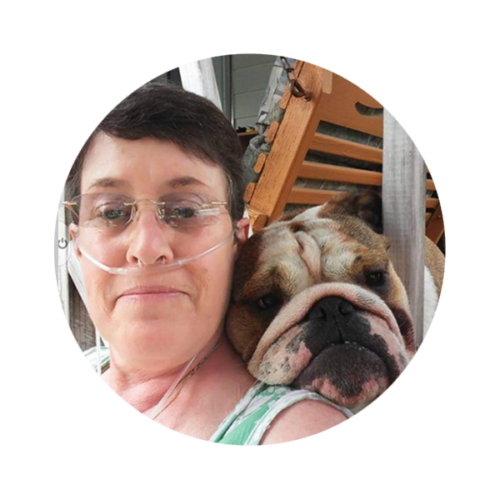
Martine’s Story
“I have eight grandchildren and four fur babies (two English bulldogs, a French bulldog, and a cat) and now I can enjoy them again.”
Procedure Details:
Age at Treatment: 51 and 65
Date of Procedure: February 2019
Hospital: Inova Fairfax Hospital, Fairfax, VA
Martine’s Story
“I have eight grandchildren and four fur babies (two English bulldogs, a French bulldog, and a cat) and now I can enjoy them again.”

Procedure Details:
Age at Treatment: 51 and 65
Date of Procedure: February 2019
Hospital: Inova Fairfax Hospital, Fairfax, VA
Life Before Zephyr® Valves:
I received my first set of Zephyr Valves 17 years ago. Let me tell you my story:
I was first diagnosed in 2005 with COPD/emphysema at 51. The doctors were shocked at how bad I was at such a young age. I was not entirely surprised though because I watched my dad go through it. We don’t have Alpha-1, but we were told there is a subset of genetics that can cause some people to develop the disease earlier, and progress quicker than most.
Before COPD, I was a force to be reckoned with, I ran my own business providing echocardiogram services for medical centers. I’ve worked in many hospitals pushing 500-pound echo machines. Before human cardiology, I worked in veterinary cardiology and would be moving around 100+ pound dogs for X-rays and scans. Outside of work, I loved to travel and water ski!
Before 2005, I had never had PFTs or scans. I was given an inhaler for “asthma” though it was COPD that I had. It was hard to quit smoking, but I just could not breathe anymore. I did manage to quit but it was too late for my lungs. I started to do my own research on treatment options and at that time the University of Maryland was doing a clinical trial on endobronchial valves2. I was very lucky to make the trial and receive my first set of valves in 2005 as part of a clinical trial 13 years before they were FDA approved.
Back when I was diagnosed, the prognosis was for 5-7 years of survival with my level of disease. But here I am 17 years later.”
– Martine
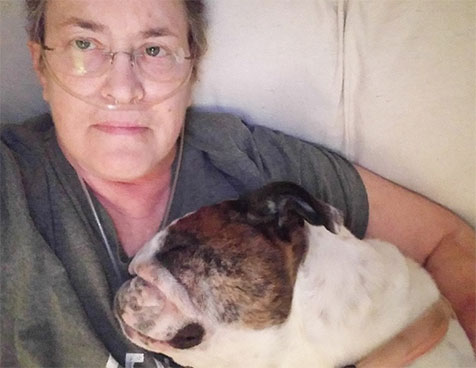
Life After Zephyr Valves:
Life after My First Set of Valves:
The first few weeks I wasn’t sure it worked but I think my body was just catching up and adjusting. A month or so later, I was up in the mountains on a jewelry retreat in the high elevation without needing oxygen. I was so grateful. That trial and those valves gave me years back of good living!
In 2011 my diseased had progressed quite a bit and I ended up having an exacerbation that put me in critical care and on oxygen 24/7. I did reach out to the transplant center and after consulting with my physician, have been in that program since then but never on the “urgent” list. Fast forward to 2019 when I decided to reach out to Dr. Mahajan at Inova. I spoke with Nancy Collar, the Lung Navigator there, and she said, “we’ve got your CT and you already have valves!” I pitched to her and said I wanted another set. I met all the criteria and within weeks I was in.
Life after My Second Set of Valves:
I received my second set of valves in 2019. I did have a pneumothorax, but we managed that, and I would still do it again in a heartbeat.
I am feeling good again, but I truly don’t think I’ve seen the full benefit. Right after my second set of valves, COVID hit so I have not been able to do my regular pulmonary rehabilitation. I know from my first time around that the pulmonary rehab exercises are very important to getting to your best place. I can’t wait to get back.
The teacher part of me is always lecturing the newbies at pulmonary rehab that “doing a little of what you don’t like (exercise) will let you do more of what you love.”
I am 67 years young, and I have two sets of Zephyr Valves. It’s not a cure and I still take my medication and use oxygen but when I get sick, I feel I bounce back quicker. When I have an exacerbation, I can get through it easier.
I’ve had a long journey and I don’t think I would be here without my valves. Back when I was diagnosed, the prognosis was for 5-7 years of survival with my level of disease. But here I am 17 years later. When I go to my pulmonary function test, they ask me to come in to show students how good someone with my advanced disease can be. I am looking forward to many more years. I want to go to the beach and walk the boardwalk. Ocean City, here I come!
Results from case studies are not necessarily predictive of results in other cases. Results in other cases may vary.
Caution: Federal law restricts this device to sale by or on the order of a physician.
1Criner, G et al. Am J Resp Crit Care Med. 2018 Nov 1;198(9):1151–1164
2Endobronchial Valve for Emphysema Palliation Trial (VENT) trial
GLO-EN-1370-v1
What is the Zephyr Valve procedure?
The Zephyr Valve has been shown to help patients breathe easier, do more, and enjoy life.1
Despite taking the best available medications, many patients with severe COPD/emphysema suffer from hyperinflation of their lungs where air becomes trapped in the lungs, preventing fresh air from entering and thereby causing severe shortness of breath.
The Zephyr Valves reduce lung hyperinflation by allowing trapped air to escape and preventing new air from entering that diseased lobe. This allows the healthier parts of the lung to function better and results in patients being able to breathe more easily and experience less shortness of breath.
The valves are placed via bronchoscopy, with no incision or cutting, so these benefits are achieved without the risks of traditional surgical options. The procedure is usually complete in under an hour.
Complications of the Zephyr Endobronchial Valve treatment can include but are not limited to pneumothorax, worsening of COPD symptoms, hemoptysis, pneumonia, dyspnea and, in rare cases, death.
-
I received my first set of Zephyr Valves 17 years ago. Let me tell you my story:
I was first diagnosed in 2005 with COPD/emphysema at 51. The doctors were shocked at how bad I was at such a young age. I was not entirely surprised though because I watched my dad go through it. We don’t have Alpha-1, but we were told there is a subset of genetics that can cause some people to develop the disease earlier, and progress quicker than most.
Before COPD, I was a force to be reckoned with, I ran my own business providing echocardiogram services for medical centers. I’ve worked in many hospitals pushing 500-pound echo machines. Before human cardiology, I worked in veterinary cardiology and would be moving around 100+ pound dogs for X-rays and scans. Outside of work, I loved to travel and water ski!
Before 2005, I had never had PFTs or scans. I was given an inhaler for “asthma” though it was COPD that I had. It was hard to quit smoking, but I just could not breathe anymore. I did manage to quit but it was too late for my lungs. I started to do my own research on treatment options and at that time the University of Maryland was doing a clinical trial on endobronchial valves2. I was very lucky to make the trial and receive my first set of valves in 2005 as part of a clinical trial 13 years before they were FDA approved.
-
Life after My First Set of Valves:
The first few weeks I wasn’t sure it worked but I think my body was just catching up and adjusting. A month or so later, I was up in the mountains on a jewelry retreat in the high elevation without needing oxygen. I was so grateful. That trial and those valves gave me years back of good living!
In 2011 my diseased had progressed quite a bit and I ended up having an exacerbation that put me in critical care and on oxygen 24/7. I did reach out to the transplant center and after consulting with my physician, have been in that program since then but never on the “urgent” list. Fast forward to 2019 when I decided to reach out to Dr. Mahajan at Inova. I spoke with Nancy Collar, the Lung Navigator there, and she said, “we’ve got your CT and you already have valves!” I pitched to her and said I wanted another set. I met all the criteria and within weeks I was in.
Life after My Second Set of Valves:
I received my second set of valves in 2019. I did have a pneumothorax, but we managed that, and I would still do it again in a heartbeat.
I am feeling good again, but I truly don’t think I’ve seen the full benefit. Right after my second set of valves, COVID hit so I have not been able to do my regular pulmonary rehabilitation. I know from my first time around that the pulmonary rehab exercises are very important to getting to your best place. I can’t wait to get back.
The teacher part of me is always lecturing the newbies at pulmonary rehab that “doing a little of what you don’t like (exercise) will let you do more of what you love.”
I am 67 years young, and I have two sets of Zephyr Valves. It’s not a cure and I still take my medication and use oxygen but when I get sick, I feel I bounce back quicker. When I have an exacerbation, I can get through it easier.
I’ve had a long journey and I don’t think I would be here without my valves. Back when I was diagnosed, the prognosis was for 5-7 years of survival with my level of disease. But here I am 17 years later. When I go to my pulmonary function test, they ask me to come in to show students how good someone with my advanced disease can be. I am looking forward to many more years. I want to go to the beach and walk the boardwalk. Ocean City, here I come!
-
The Zephyr Valve has been shown to help patients breathe easier, do more, and enjoy life.1
Despite taking the best available medications, many patients with severe COPD/emphysema suffer from hyperinflation of their lungs where air becomes trapped in the lungs, preventing fresh air from entering and thereby causing severe shortness of breath.
The Zephyr Valves reduce lung hyperinflation by allowing trapped air to escape and preventing new air from entering that diseased lobe. This allows the healthier parts of the lung to function better and results in patients being able to breathe more easily and experience less shortness of breath.
The valves are placed via bronchoscopy, with no incision or cutting, so these benefits are achieved without the risks of traditional surgical options. The procedure is usually complete in under an hour.
Results from case studies are not necessarily predictive of results in other cases. Results in other cases may vary.
Caution: Federal law restricts this device to sale by or on the order of a physician.
– Martine

¹Criner, G et al. Am J Resp Crit Care Med. 2018 Nov 1;198(9):1151–1164
2Endobronchial Valve for Emphysema Palliation Trial (VENT) trial

